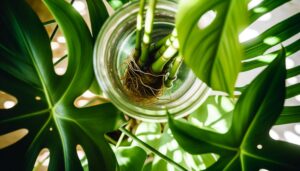Monstera Adansonii No Holes in Leaves: Causes and Solutions!
If your Monstera Adansonii has no holes in its leaves, several key issues might be at play. Insufficient light is often a primary factor; place it where it gets filtered sunlight or use grow lights.
Low humidity can also inhibit fenestration, so consider a humidifier or misting. Nutrient deficiencies, especially in nitrogen, prevent leaf development; use a balanced fertilizer.
Inconsistent watering stresses the plant, disrupting growth. Make sure your pot has good drainage and use a well-aerated soil mix.
Finally, inspect for pests, as infestations can impair growth. Addressing these aspects will promote healthier, fenestrated leaves.
Explore more details to optimize your plant care.

Key Takeaways
- Ensure Monstera Adansonii receives filtered sunlight to promote proper leaf fenestration.
- Maintain high humidity levels using a humidifier, pebble tray, or misting to prevent stunted growth.
- Provide balanced nutrients, especially nitrogen, phosphorus, and potassium, to support healthy leaf development.
- Water consistently, ensuring soil moisture is adequate without waterlogging, to prevent stress and support leaf formation.
- Use a well-draining soil mix and appropriately sized pot to support healthy root growth and leaf development.
Insufficient Light
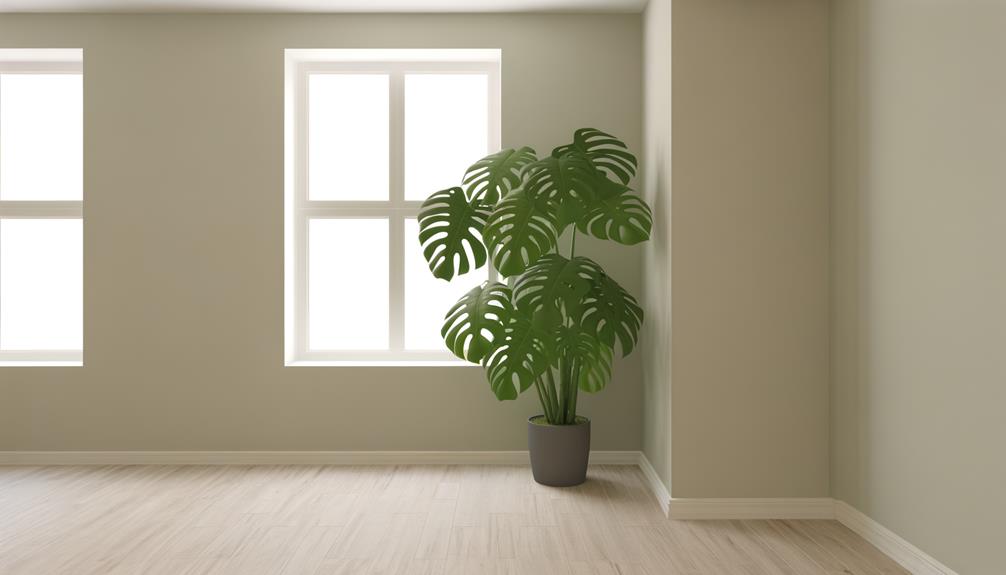
One of the primary reasons your Monstera adansonii may not develop holes in its leaves is due to insufficient light exposure. This species, native to tropical rainforests, thrives under filtered sunlight. Without adequate light, photosynthesis slows, impacting fenestration.
Position your plant near a bright, indirect light source. Avoid direct sunlight as it can scorch the leaves. In low-light conditions, consider using a grow light to supplement natural light. Aim for 12-14 hours of light daily to mimic the plant’s natural environment.
Monitor leaf color; pale or yellowing leaves might indicate inadequate light. Consistent lighting conditions promote healthy growth and encourage the formation of characteristic leaf perforations. Proper light is essential for the physiological processes that result in fenestration.
Inadequate Humidity
You’re probably noticing that low atmospheric moisture levels can inhibit the formation of fenestrations in Monstera adansonii leaves. When humidity drops below 50%, the plant’s physiological processes, such as transpiration and nutrient uptake, may become compromised.
To address this, consider using a humidifier or placing the plant on a pebble tray with water to maintain best humidity levels.
Low Moisture Impact
Insufficient humidity levels can impede the formation of fenestrations in Monstera adansonii leaves, as these plants thrive in consistently moist environments. When humidity drops below ideal levels, cellular processes within the plant are disrupted, hindering the development of characteristic leaf holes.
Low humidity affects transpiration rates, leading to:
- Stunted Growth: Reduced transpiration limits nutrient and water uptake, slowing growth.
- Leaf Curling: Leaves may curl to minimize water loss, signaling stress.
- Browning Edges: Margins of leaves may turn brown and crispy due to dehydration.
- Increased Susceptibility to Pests: Dry conditions can weaken plant defenses, making them more prone to infestations.
Monitoring and maintaining appropriate humidity levels is essential for the healthy fenestration of Monstera adansonii leaves.
Humidity Solutions
To address insufficient humidity for Monstera adansonii, you can utilize several effective strategies to maintain ideal moisture levels. First, place a humidifier near your plant to consistently release moisture into the air. Aim for a relative humidity level between 60-80%.
Alternatively, create a humidity tray by filling a shallow dish with pebbles and water, making sure the pot sits above the waterline to prevent root rot. Misting the leaves regularly can also temporarily boost humidity, although it’s less consistent.
Grouping plants together can create a microenvironment that retains moisture. Additionally, monitor your indoor climate with a hygrometer to ensure best conditions. These methods will help your Monstera adansonii thrive and develop the characteristic fenestrations.
Nutrient Deficiency
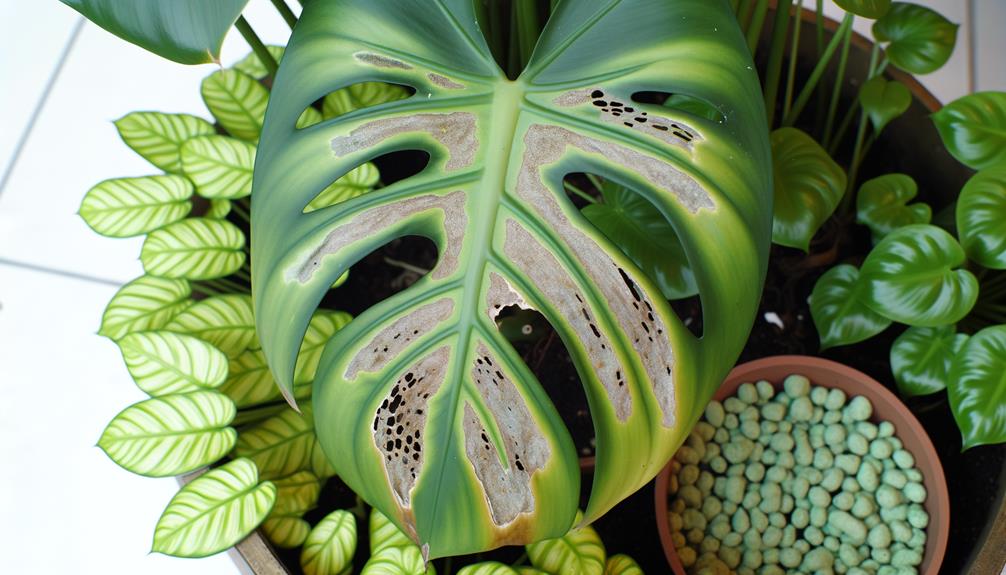
You need to guarantee your Monstera Adansonii receives essential nutrients like nitrogen, phosphorus, and potassium for best growth. Nutrient deficiencies can manifest as yellowing leaves, stunted growth, or lack of characteristic holes.
Regularly monitor your plant’s condition to identify and address any symptoms of nutrient deficiency promptly.
Essential Nutrients Required
Frequently, a lack of necessary nutrients like nitrogen, phosphorus, and potassium can lead to Monstera adansonii leaves developing without their characteristic holes.
These macronutrients play essential roles in plant growth and development:
- Nitrogen (N): Important for chlorophyll synthesis, it promotes vigorous leaf growth and enhances metabolic functions.
- Phosphorus (P): Required for energy transfer and genetic material formation, it supports root development and flowering.
- Potassium (K): Critical for regulating stomatal functions and enzyme activation, it enhances drought resistance and overall plant health.
- Calcium (Ca): Significant for cell wall structure and membrane stability, it aids in root and leaf development.
Ensuring a balanced supply of these nutrients can prevent morphological abnormalities, like the absence of fenestrations in Monstera adansonii leaves.
Identifying Deficiency Symptoms
Recognizing nutrient deficiency symptoms in Monstera adansonii involves observing specific physical changes in the plant. If you notice chlorosis, or yellowing of the leaves, it could indicate a nitrogen deficiency.
Stunted growth and small, pale leaves may suggest a lack of phosphorus. Potassium deficiency often presents as browning or scorching at the leaf edges.
Magnesium deficiency results in interveinal chlorosis, where veins remain green while the rest of the leaf turns yellow. Iron deficiency can cause young leaves to turn yellow while older leaves stay green.
Make sure you’re providing balanced nutrients and monitor these symptoms closely. Early identification and correction of nutrient deficiencies are important for maintaining the health and aesthetic appeal of your Monstera adansonii.
Improper Watering
Inconsistent watering schedules can lead to stress in Monstera Adansonii, potentially inhibiting the formation of characteristic fenestrations in its leaves. Ensuring proper hydration is vital for peak leaf development.
When you water irregularly, the plant’s cellular processes become disrupted, affecting photosynthesis and nutrient uptake.
To maintain a consistent watering routine, consider these steps:
- Monitor soil moisture: Use a moisture meter to gauge when the top 1-2 inches of soil are dry.
- Establish a schedule: Water approximately once a week, adjusting for environmental conditions.
- Ensure drainage: Excess water should freely exit the pot to prevent root rot.
- Use room-temperature water: Extreme temperatures can shock the roots, impeding growth.
Pot Size and Soil
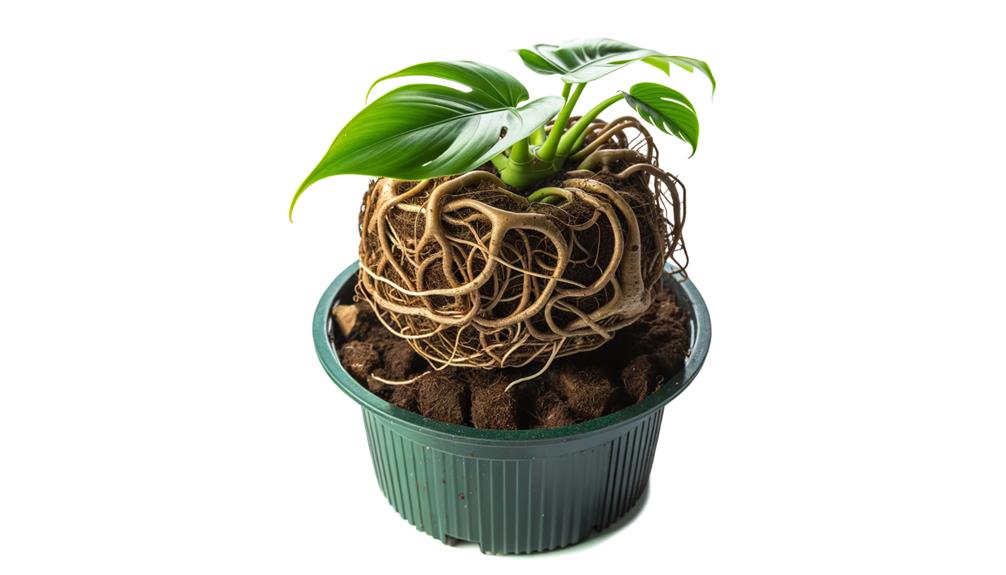
Proper watering is just one part of the equation; selecting the right pot size and soil composition is equally important for promoting healthy fenestrations in Monstera Adansonii leaves.
Use a pot that’s one size larger than the root ball to avoid root-bound conditions, which can stunt growth. Confirm the pot has drainage holes to prevent waterlogging.
Opt for a well-draining soil mix rich in organic matter, such as a combination of peat moss, perlite, and orchid bark. This blend provides excellent aeration and moisture retention, mimicking the plant’s natural habitat.
Avoid heavy, compacted soils, as they can suffocate roots and impede nutrient uptake, ultimately affecting leaf development and fenestration formation.
Plant Age
The age of your Monstera Adansonii plays an essential role in the development of fenestrations. Younger plants typically exhibit solid leaves, while mature specimens are more likely to showcase the characteristic holes. Understanding this growth pattern can help you manage expectations and care routines.
To ensure your plant reaches maturity and develops fenestrations:
- Patience: Allow time for natural growth. Younger plants need several months to years to mature.
- Optimal Conditions: Provide adequate light, humidity, and nutrition to promote healthy development.
- Growth Support: Use stakes or trellises to support vertical growth, simulating natural climbing behavior.
- Regular Monitoring: Observe leaf development to identify the shift from juvenile to mature stages.
Pests and Diseases
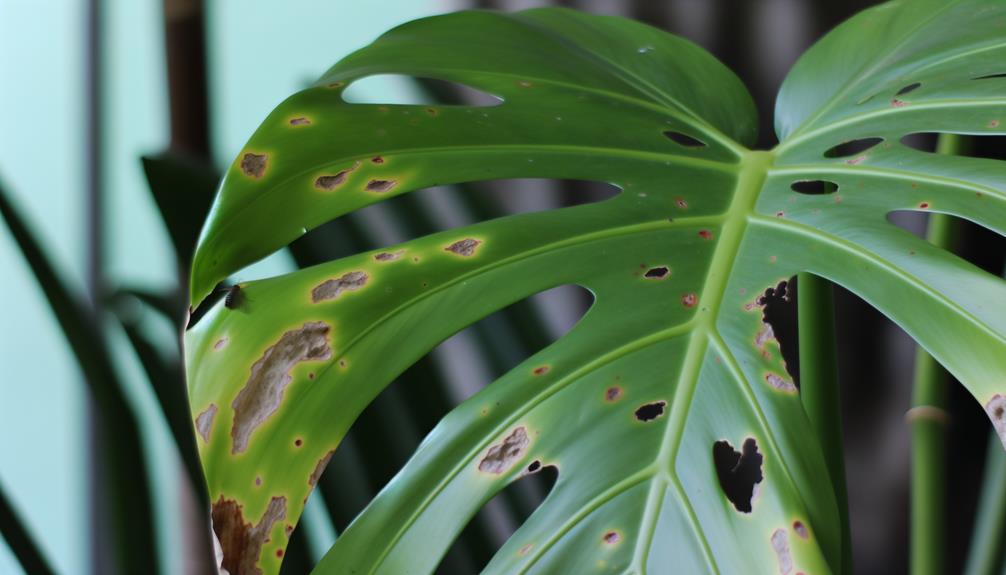
Maintaining the health of your Monstera Adansonii as it matures also involves vigilant monitoring for pests and diseases, which can impede leaf development and overall plant well-being. Common pests include spider mites, mealybugs, and scale insects. These pests feed on the plant’s sap, leading to stunted growth and malformed leaves.
Inspect your plant regularly, focusing on the undersides of leaves and stems, where these pests often reside.
Diseases such as root rot and leaf spot can also be harmful. Root rot, caused by excessive watering or poor drainage, results in blackened, mushy roots. Leaf spot, identified by brown or black spots with yellow halos, is often fungal.
Implement proper watering practices and maintain adequate air circulation to prevent these issues.
Conclusion
To sum up, ensuring your Monstera adansonii develops its characteristic holey leaves involves addressing several factors: light, humidity, nutrients, watering, pot size, soil, plant age, and pests.
Did you know that plants receiving insufficient light can exhibit up to 40% less fenestration?
By optimizing these conditions, you’ll foster a healthier plant with the iconic fenestrations.
Remember, consistent care and attentive adjustments are key to cultivating a thriving Monstera adansonii with those sought-after perforated leaves.



